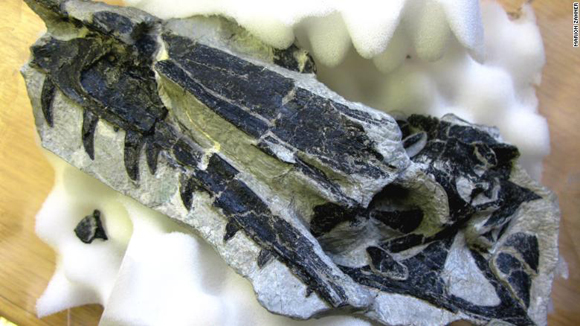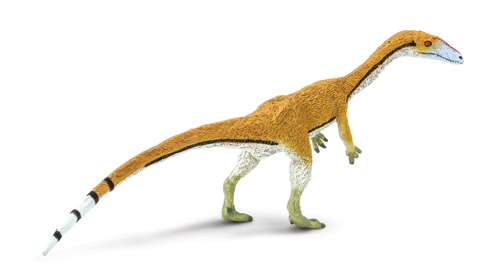Notatesseraeraptor frickensis – A Mixture of Coelophysid and Dilophosaurid Characteristics
A new European theropod dinosaur from the Late Triassic of Switzerland has been named and described this week. This is big news, as very little is known about Late Triassic theropods that roamed Europe more than 200 million years ago, only a handful have been described to date, just four species. The dinosaur has been named Notatesseraeraptor frickensis (No-tah-tess-er-ray-rap-tor frick-ensis), the genus name derives from the Latin “nota” meaning feature and “tesserae”, a Latin term to describe tiles used to create a mosaic, a reference to the mixture of anatomical features (dilophosaurid and coelophysoid) identified in the fossil bones
The trivial name honours the Swiss town of Frick, where the fossils were found.
The Body Plan, Known Fossil Material and a Skeletal Reconstruction of N. frickensis

Picture credit: Nature: Ecology and Evolution
Lizard-eating Dinosaur
The partially articulated specimen was collected in 2006 from the famous Gruhalde clay pit in the town of Frick (Aargau Canton, northern Switzerland). This clay pit has yielded large numbers of Plateosaurus fossils, although Notatesseraeraptor layer is located above the classic Plateosaurus bone beds. The strata are from the middle part of the Gruhalde Member of the Klettgau Formation and represents Late Triassic (end-Norian) sediments. The fossils associated with N. frickensis include a nearly complete skull, articulated forelimbs, vertebrae, hip bones and ribs. The body cavity revealed the remains of a Clevosaurus, a lizard-like rhynchocephalian, distantly related to the extant Tuatara of New Zealand. It is likely that the Clevosaurus remains represent this dinosaur’s last meal.
The Skull of Notatesseraeraptor frickensis

Notatesseraeraptor frickensis A Carnivorous Dinosaur Reported from Switzerland
Around 90% of the skull material was excavated, giving Notatesseraeraptor one of the most complete carnivorous dinosaur skulls known from before the Late Jurassic. Although, our knowledge of early theropod dinosaurs has improved greatly since the turn of the century, thanks mainly to fossil discoveries from North and South America, very little is known about the evolution and radiation of Late Triassic/Early Jurassic European theropods, their fossil record is notably sparse. This new theropod species is the first meat-eating dinosaur to be described from Switzerland.
Notatesseraeraptor displays a mix of characteristics typically seen either in coelophysids or in dilophosaurids. A phylogenetic analysis suggests that it is a member of the Neotheropoda clade with affinities to Dilophosaurus of the Early Jurassic and that Notatesseraeraptor is a basal member of that line of theropods that led to the Averostra (a group, of carnivorous dinosaurs that includes the ceratosaurs).
The Late Triassic/Early Jurassic European Theropods
The nearly complete skull will help palaeontologists to better understand the evolutionary relationships between different types of Late Triassic/Early Jurassic theropod dinosaur. The fossil specimen suggests a sub-adult with a length of between 2.6 to 3 metres, but this is speculation based on comparative analysis with dinosaurs such as Coelophysis and Tawa as the length of the tail of Notatesseraeraptor is not known.
A Life Reconstruction of a Typical Coelophysid Dinosaur (Coelophysis bauri)
The picture (above) shows a Coelophysis model from Safari Ltd.
To view this model range: Wild Safari Prehistoric World.
The three previously described species of Late Triassic European theropod are:
- Liliensternus liliensterni – named in 1934 (von Huene) from the Middle and Late Norian of Germany
- Procompsognathus triassicus – named in 1913 (Fraas) also from the Middle to Late Norian of Germany
- Lophostropheus airelensis named in 1993 known from slightly younger rocks (Late Rhetian to Hettangian – Late Triassic to possibly Early Jurassic)
With the exception of a few scraps of bone associated with Liliensternus skull material and the recently described Dracoraptor hanigani from south-Wales, no other skull material has been found relating to a neotheropod dinosaur from the Late Triassic/Early Jurassic in the whole of Europe.







Leave A Comment